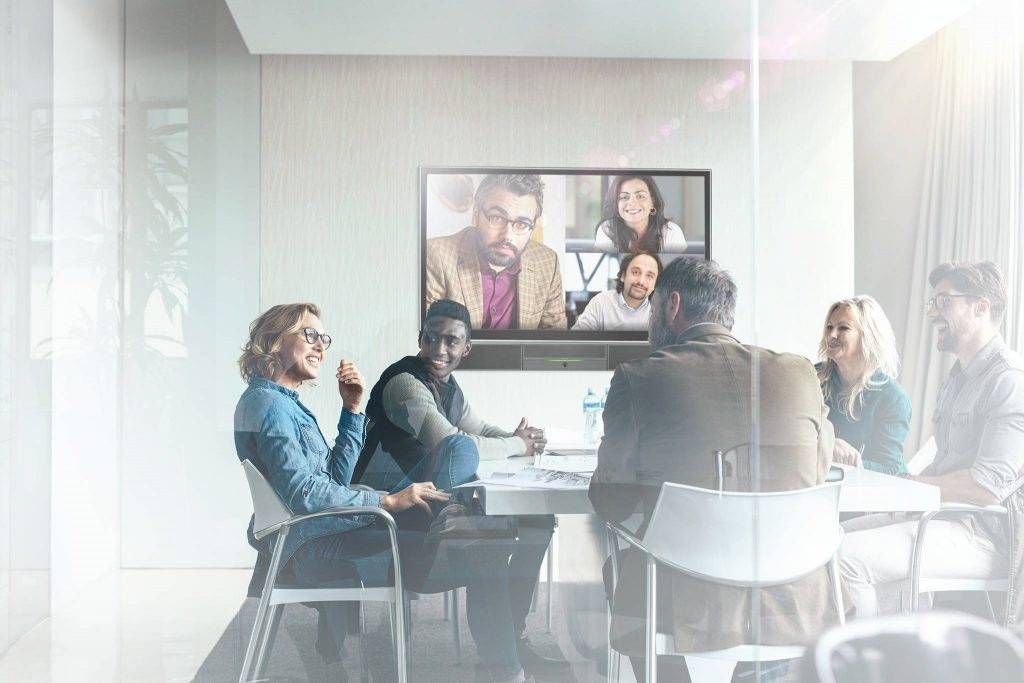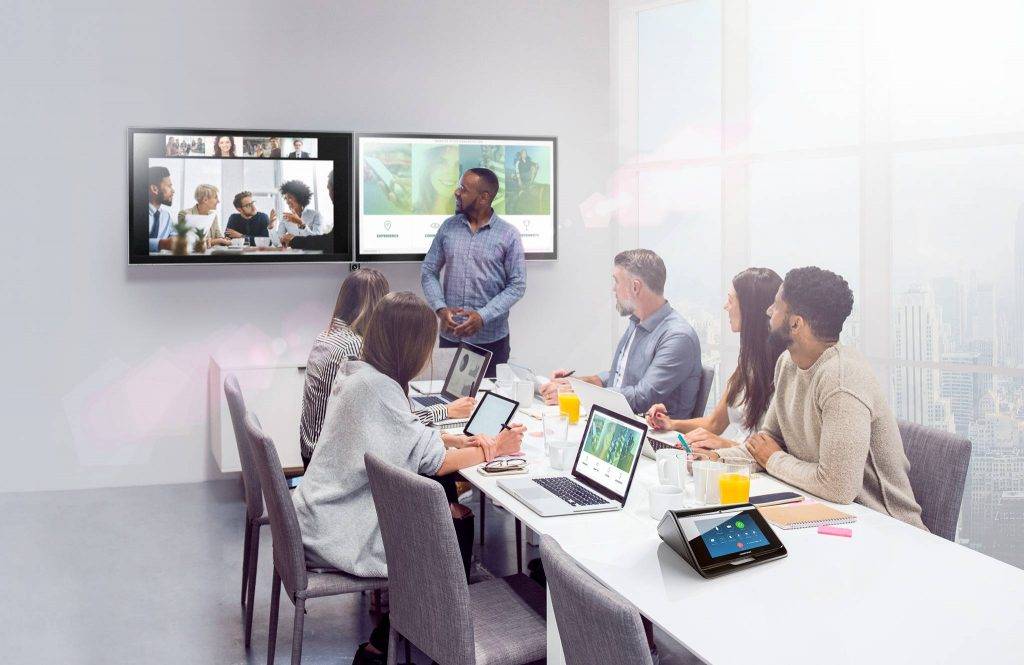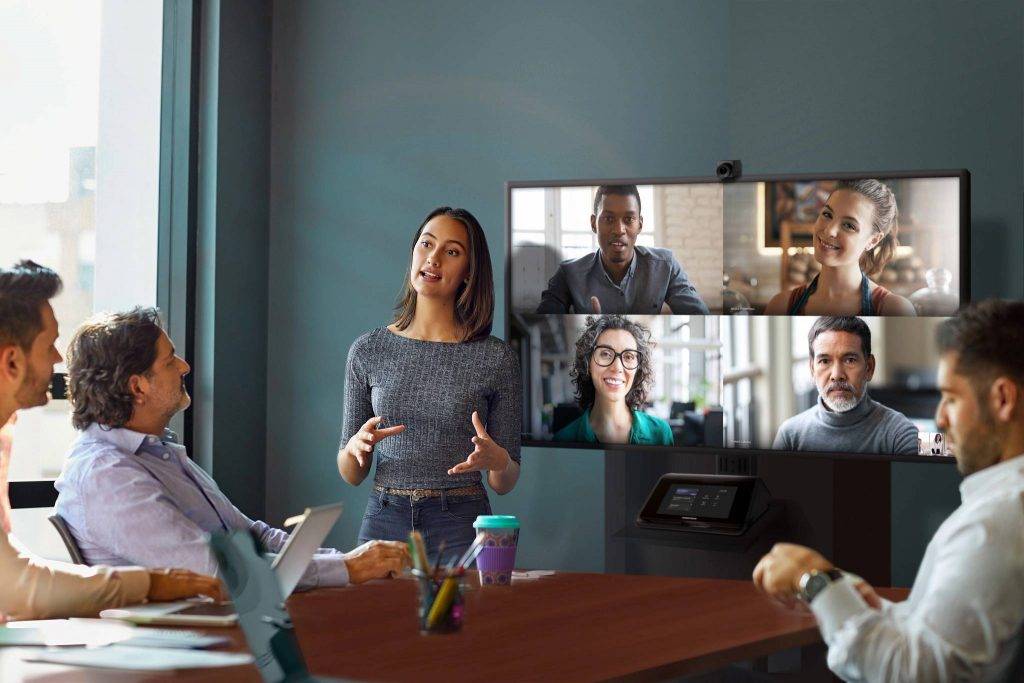There are plenty of videoconferencing systems available on the market. Picking the right software and hardware for your business will enable you to hold professional video conferences and improve collaboration among employees.

There is a wide range of hardware and software available for video conferencing
Videoconferencing has become an essential workplace tool for communication, enabling collaboration from afar and saving you time and travel expenses. However, in order to utilize this method of communicating effectively, the technical requirements must be met. In other words: You will need both appropriate videoconferencing software AND hardware to carry out a successful conference. The higher quality of your video conferencing technology, the more options you’ll have available for professional collaboration.
Of course, it’s also important to make sure that your hardware is compatible with your chosen software. With so many providers and manufacturers to choose from, it pays to compare video conferencing systems before making a purchase. It’s also important to educate yourself on the topic: what software and hardware work best for virtual meetings? How do different manufacturers stack up in a video conference hardware comparison? What platforms and tools are available, and what sets them apart? Here at GMS, we have the answers!

Video conferencing systems compared
When comparing video conference systems, it is first important to distinguish between hardware and software. Although they are ultimately inseparable from each other, the providers and manufacturers differ. The choice of both the videoconferencing software and hardware depends on various factors. A central criterion is room size. Therefore, we present you with a comparison of video conferencing systems for different types of meeting rooms:
- For small rooms that seat up to five people, a professional video soundbar is the way to go. Compared to other videoconferencing systems, this is a high-quality all-in-one solution that combines all the components into one unit. Various manufacturers offer corresponding hardware, including Bose, Logitech, and Poly. Make sure that the video soundbar you choose is certified for the videoconferencing software you’re using to ensure optimal compatibility.
- For medium-sized rooms that accommodate six to eight people, we recommend integrating a real room system–such as Microsoft Teams or Zoom. With video conferencing software, lighting conditions, and acoustics in your meeting room taken into consideration, along with the defined purpose of use for the space provided by you, we compare different videoconferencing systems on your behalf. The individual hardware components are then selected and implemented as an integrated conference system on a per-case basis. Our preferred manufacturers for this include Crestron and Lenovo among others.
- Large meeting rooms: Since an integrated video conference system should always be used for a large conference room with more than eight people, the complexity and thus also the level of investment increases. In addition to the video conferencing software, professional microphones, speakers and cameras are required. A professional media control system is also essential for large meeting rooms. However, compared to video conferencing solutions for smaller spaces, the selection is rather limited. Leading hardware manufacturers are Crestron and Yealink. In any case, you should have a professional plan for your media technology needs ahead of time.

The advantages of using a videoconference software provider – an overview
When looking for the right virtual meeting platform for your business, it is important to compare the different options in terms of their features and capabilities. While some criteria can be helpful in making your selection, we recommend that you also take a look at the different software providers when doing your videoconferencing system comparison. This will give you a better idea of what is available and make it easier to find one that meets your specific needs. Are you looking to work on documents with colleagues and share presentations across screens? Or are face-to-face meetings and high-quality audio and visual a priority? Consider your desired features when comparing videoconferencing systems. Here is an overview of leading providers of video conferencing software:
- Zoom is a scalable video conferencing platform that is known for its easy-to-use interface and excellent video quality. The ability to share multiple screens simultaneously makes it especially convenient for large meetings.
- Microsoft Teams: This video conferencing software is a part of Office365, and as a result, is used by many businesses. The focus of this software isn’t limited to audio or videoconferences; rather, it’s also possible to work on documents together and manage them securely. Chat features and integrations with other apps make Microsoft Teams a comprehensive collaboration platform.
- Cisco Webex: This video service from Cisco was long one of the market leaders in professional video conferencing. Here, security and stability are paramount. Therefore, Cisco Webex is often used by customers with high IT security requirements.
- Google Meet: This video conference software is part of the G Suite and therefore often the preferred platform for its users.
- GoToMeeting is a webinar platform that was designed for interactive learning content but also offers classic video conferencing features.
- BlueJeans: The platform for virtual meetings is primarily used as an Interop service to connect Microsoft Teams, Zoom, and Cisco Webex.
- Pexip: This is a leading provider in ensuring interoperability between various video conferencing platforms.

Video Conference Hardware Manufacturers Compared
There are also large differences in video conferencing hardware. For example, the leading manufacturers have specialized in different platforms or set technical priorities. Here is a small overview of the most common manufacturers of video conference hardware compared:
- Lenovo is mostly known for PCs, but today the company has an expansive portfolio of hardware for meeting rooms based on Microsoft Teams and Zoom.
- For many years now, Logitech has had webcams in its product range. But the manufacturer is also one of the leading providers worldwide when it comes to solutions for professional meeting rooms.
- Crestron has long been the leading manufacturer of media controls and signal management. With the introduction of the Flex series, Crestron has brought a product to market that is specifically tailored for Zoom and Teams rooms.
- Yealink’s product catalog offers a wide range of video conference products for rooms of any size and is especially popular among small to medium businesses.
- Poly, formerly known as Polycom, has been producing hardware for professional video conference rooms for many years. The company has gradually specialized in Zoom and Microsoft Teams videoconferencing systems hardware production from an infrastructure provider.
- DTEN concentrates its efforts on solutions for Zoom Rooms.
- Neat is a Norwegian startup that was initially only active in the Zoom hardware space. Now Neat has also certified for Teams room systems and is trying to gain market share primarily through innovation.
- Cisco is one of the most experienced market participants in the field of professional video conferencing. Cisco hardware is mainly used in conjunction with the Cisco Webex platform but is also opening to support Microsoft Teams.

Looking for a professional video conferencing system? GMS has you covered.
No matter which video conferencing system you choose, investing in modern hybrid work equipment will pay off. GMS would be glad to advise you and compare video conferencing systems with a view to your individual needs. As a full-service provider, of course, we are also available for the planning and implementation of your video conference software and hardware. Get in touch with us!